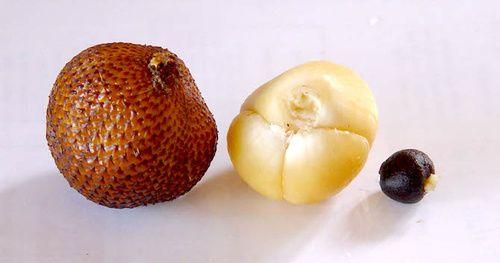Il snakefruit, or snake fruit, is the fruit of a small palm native to Indonesia. Note for properties antioxidants, it is useful for fighting aging, l'anemia, vision problems and diarrhea. Let's find out better.
> Calories, nutritional composition and properties of Salak
> Contraindications of Salak
> How to eat Salak

Description of the fruit
The salak (Salacca zalacca), also known as snake fruit, is the fruit of a tree (a small palm) native to Indonesia: Bali, Sumatra and Java. Over the centuries it has spread throughout South East Asia, in particular it can be found throughout Indonesia, Malaysia, Thailand and Burma.
The salak fruit is the size and shape of a fig and the light pulp (perfectly snowy or yellowish depending on the variety) is divided into three sections and covered with a brown skin, similar to the scales of a snake, firm and crumbly.
Between the peel and the pulp there is a white film that is important to eat together with all the pulp without removing it. It is a juicy fruit, universally considered pleasant and tasty, sweet with a sour tail aftertaste. Some varieties are particular and sought after: extremely sweet or dry, crunchy and crumbly.
Salak, ally of
Circulatory system, eyesight, liver, stomach and kidneys. Ideal in cases of anemia, vision problems, diarrhea.
Calories, nutritional composition and properties of salak
Salak contains 82 kcal per 100 g.
The pulp of the salak is known for its antioxidant qualities, and is traded outside the countries of origin above all for this reputation: it has a strong ability to fight the signs of aging, to safeguard joint health, to support cell regeneration and to detoxify the body.
This is given in particular by the good contents of ascorbic acid and flavonoids and one of the highest levels of iron among all known fruits. It provides 50 calories per 100 grams of pulp ed abounds in potassium, pectin and saponin.
The good levels of provitamin A make it report among the folk remedies for vision problems. Consistent consumption of salak is helpful in combating diarrhea and other similar ailments.
The particular tannins e dietary fiber of particular quality are suitable for slimming diets. It also helps relieve heartburn and support treatment for some vision problems, especially hyperopia.
Salak among the natural supplements for the eyes and sight

Contraindications of salak
If you are careful not to remove the transparent membrane just below the peel and not to inadvertently bite too hard the hard seeds contained in the pulp, salak it does not present any particular contraindication.
Curiosity
There are some varieties considered very valuable and particularly expensive and sought after: one of these is the "Gula pasir" (sugar grains) considered the sweetest, while another is the "pondoh ”Balinese, considered the most aromatic.
How salak is eaten
The peel is quite easy to peel completely: inside we find the pulp covered with one thin transparent membrane, a film that covers the pulp wedges. It is recommended to do not remove it because various enzymes are concentrated inside which facilitate the digestion of salak; the few cases of digestive problems and intestinal blockages resulting from the consumption of this fruit are always linked to the removal of this film.
In addition to fresh consumption, the salak has various uses in cooking: the pulp can come dried, boiled, fried, caramelized, made into chutney. With the sweetest and juiciest species, a famous alcoholic in the countries of origin is also produced.
READ MORE
Properties, benefits and contraindications of the berries of the 5 flavors
In collaboration with Giacomo Colomba
| Wikipedia


























